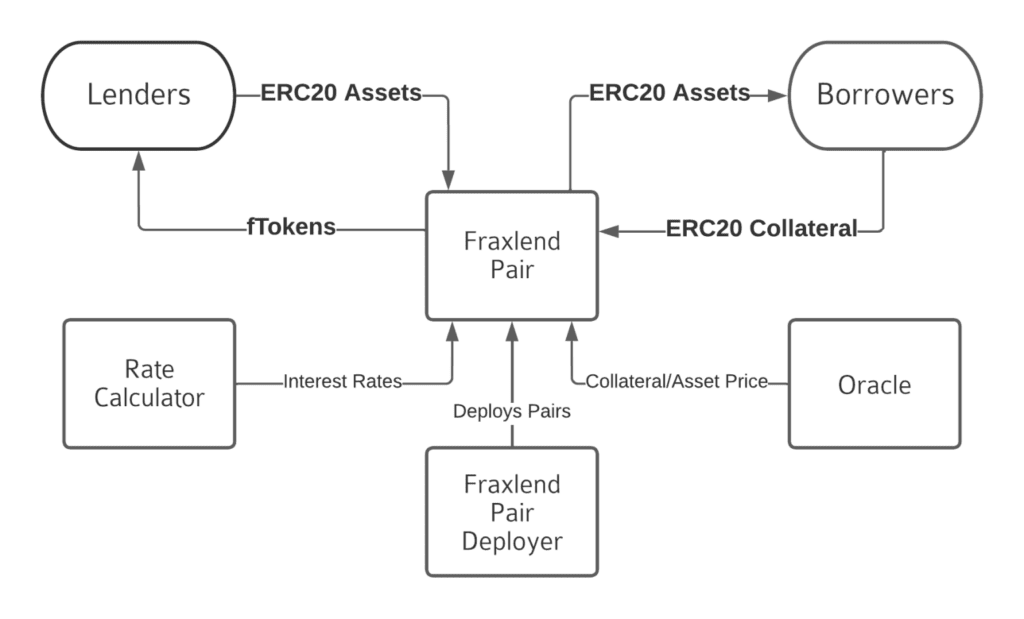Frax Finance Review: Project To Eliminate Weaknesses of Algorithmic Stablecoins
Frax Finance sounds like an interesting concept! By integrating the functionalities of Curve, UniSwap, and AAVE into a single platform, it could provide users with a comprehensive DeFi experience. Let’s learn details about this project with Coincu through this Frax Finance Review article.

What is Frax Finance?
Frax Finance is the name of a DeFi initiative that offers a number of multi-chain goods. Frax Finance refers to a complete ecosystem of Defi goods and services, including Frax Protocol (or Frax Finance Protocol), Fraxlend, Fraxswap, stablecoin FRAX, and so on.
The project is the pioneering initiative in the paradigm of partly reserved algorithmic stablecoins (Fractional Algorithmic). The purpose of Frax Finance is to develop a decentralized, stable, scalable, and capital-efficient stablecoin. The Frax Finance network’s mechanism is made up of two tokens:
- FRAX: Frax Finance is an algorithmic stablecoin that is partially collateral-backed and partly algorithmically stable.
- Frax Shares (FXS): The Frax Finance network’s governance and utility token. FXS is accumulated with the value from the unsecured FRAX rate, fees, and protocol revenue.
Prior to the introduction of the Frax Protocol, stablecoins were classified into three types:
- Collateral stablecoin using fiat, real-world assets issued by a non-traditional company/consortium: USDT from Tether, USDC from Circle, or BUSD from Paxos.
- Crypto-collateral: There include CDP systems such as Maker DAO, that issue DAI, Venus, that issue VAI; and Parrot, that issue PAI.
- There is no need for collateral since the system is entirely algorithmic.
Frax Finance introduces a fourth form of stablecoin: a fractional-algorithmic stablecoin, whose exchange rate stability mechanism is partly dependent on algorithms and partially backed by other assets.
Frax is now being implemented on Ethereum and 12 other blockchains, along with two stablecoins, FRAX (anchor to USD rate) and FPI (anchor to US CPI, not yet launched). The Frax protocol’s ultimate purpose is to create a highly scalable, decentralized cryptocurrency in substitute of digital assets with a fixed supply, such as BTC.

Frax Finance’s approach to developing Web-Apps, or what Frax Finance hopes to provide to consumers, is to give Defi services on an All-in-One platform that exists on several chains with strategic items such as:
- FRAX – Stablecoins
- FraxSwap – AMM DEX
- FraxLend – Lending protocol
Now, the Frax Finance Review article will find out how the project works.
How does it work?
Mechanism for mortgages
USDC is originally completely collateralized FRAX. Later, as stablecoin demand grew and mortgage rates fell, FRAX was partly collateralized with FXS and USDC. FXS, which works similarly to the LUNA/UST method, supports the algorithm component of FRAX.
Frax Mining Process: The user inputs $0.88 USDC and xFXS has a value of 0.12$ to the protocol, resulting in a total valuation of $1. The user is then given one FRAX unit. Since the fraction of FXS delivered into the protocol will be burnt, each FRAX held by the user is only backed by $0.88 USDC.
Mortgage Withdrawal Procedure: The user returns FRAX to the protocol for burning. The protocol generates an appropriately valued quantity of yFXS equal to $0.12 (y may vary, maybe equal to x owing to variable FXS pricing) plus $0.88 collateralized USDC, which is returned to the customer.
- Where F is the minted FRAX unit.
- Y is the unit of USDC loaded into the system. Py is the USDC/USD rate.
- Z is the FXS unit loaded into the system. Pz is the FXS/USD rate.
- Cr is the USDC Mortgage Rate.
The collateral method described above serves as the foundation for the exchange rate stabilization mechanism described below.
Exchange rate stabilization mechanism
FRAX supply is changed to fit market supply and demand by focusing on market players’ interests.
Considering the secondary market price of FRAX is larger than $1 for any reason, it is comprehensible that the demand for FRAX exceeds the supply. Assuming that FRAX always respects the mortgage rule, anybody may mint FRAX for $1 and sell it on the secondary market for more than $1 to benefit from the exchange rate difference. At this moment, the supply of FRAX has been increased.
When the price of FRAX on the secondary market is less than $1, anybody may acquire it and use the Frax Protocol to withdraw $1 in USDC and FXS. The supply of FRAX is presently diminishing, while demand in secondary markets is increasing, causing FRAX to revert to the peg price of $1.
FRAX’s price volatility is therefore transferred to the FXS. Depending on the circumstances, this might be beneficial or detrimental. If the supply of FRAX continues to rise, more FXS will be burnt, deflating the supply of FXS.
The protocol uses Algorithmic Market Operations (AMO) to achieve stability in the first version – Frax v1. Every one hour, if FRAX is greater than $1, Cr (USDC collateral rate) decreases by 0.25%, if FRAX is less than $1, Cr increases by 0.25% to increase the collateral structure in USDC, and Cr stays the same when Frax price = 1.
Frax v2 expands on the AMO concept introduced in v1 by aiming to operate as many AMOs as possible in order to enhance protocol, boost privacy and capital efficiency, and empower FXS holders more. This allows the protocol to mint extra FRAX when the price is more than $1 in order to return the price to $1.
AMOs may be openly suggested and formed by the community, but they must be approved by a governance vote before they can be implemented. Today, four AMOs have been deployed, with two more in the works.
The Frax system receives FRAX and FXS collateral pricing data through Oracle Chainlink and Uniswap.
FRAX
FRAX is an algorithmic stablecoin with price stability achieved by asset collateralization. Mortgage rates are adjusted hourly to the value of FRAX by 0.25%.
To develop stability for the protocol before permitting collateral with many other assets, the assets used as collateral to produce FRAX are currently only stablecoins such as USDT and USDC.
FRAX is always created/redeemed with a value of one dollar. As FRAX exceeds $1, a reward is created that motivates users to mint additional FRAX. When FRAX is less than $1, however, there is an advantage to redeeming FRAX.
The overall value of FRAX created (mine) is guaranteed to be equal to the sum of the collateral value at the collateral rate and the FXS value (the number of FXS to be burned). When FRAX is redeemed, the user receives the collateral as well as FXS at the same value (this FXS is generated).
Moreover, following the release of Frax V2, Frax used Curve’s governance architecture, which is Vote Escrowed (ve). You will need to lock FXS in order to obtain veFXS for administration and prizes.

Fraxswap
Fraxswap is Frax Finance’s AMM, and it is based on Uniswap V2.
Fraxlend
Frax Finance cannot construct a comprehensive DeFi ecosystem without a lending platform – a decentralized capital market. Fraxlend is a freshly released loan platform by Frax Finance.
Anybody may generate liquidity between two ERC-20 tokens using Fraxlend, and everyone can develop and participate in lending and borrowing operations.

The following people are involved in the loan process on Fraxlend, according to the diagram above:
- FraxLend Pair: This is similar to a loan contract in that the contract will record the collateral and the lending assets are ERC20 tokens. Fraxlend Pair Deployer, the makers of this asset pair, implemented it.
- Lenders: Lenders that deposit Token Asset into the Fraxlend Pair will get interest in fTokens. Lending tokens may be traded for fTokens.
- Borrowers: Borrowers deposit tokens as collateral into Fraxlend Pair in order to borrow Token Asset.
- Rate Calculator is in charge of calculating interest rates.
- The market pricing for both the Asset Token and the Collateral Token is determined by one (or two) ChainLink Oracles in each contract.
In the liquidation procedure, this approach remains identical to previous loan arrangements. Each borrower’s position is governed by an LTV, which is the ratio of the value of the borrowed asset to the value of the collateral placed. As the exchange rate between Token Asset and Collateral Token changes, LTV changes. When a borrower’s LTV (Loan to value) exceeds the limit LTV, he or she might add collateral or repay the loan to put the LTV back into a safe range. Instead, anybody may return all or part of the loan on the borrower’s behalf and earn the collateral’s value plus a liquidation fee.
FXS token
Key Metrics
- Token Name: Frax Share
- Ticker: FXS
- Blockchain: Ethereum
- Token Standard: ERC-20, Bep-20, PRC-20, SPL
- Contract:
- ERC-20: 0x3432b6a60d23ca0dfca7761b7ab56459d9c964d0
- BEP-20: 0xe48a3d7d0bc88d552f730b62c006bc925eadb9ee
- PRC-20: 0x1a3acf6d19267e2d3e7f898f42803e90c9219062
- SPL: 6LX8BhMQ4Sy2otmAWj7Y5sKd9YTVVUgfMsBzT6B9W7ct
- Token type: Utility, Governance.
- Total Supply: 99,707,753 FXS
- Circulating Supply: 72,740,215 FXS
Token Allocation
- Liquidity Mining: 60%
- Team:20%
- Token Sale: 12%
- Treasury: 5%
- Advisors: 3%
Use Cases
The FXS token serves the following purposes:
- It is a token for project management
- FRAX is created by combining it with collateral.
Team
Frax Finance’s team is primarily made up of people from previous initiatives, such as Everipedia, a Wikipedia Blockchain, and DecentralBank.
- Sam Kazemian – CEO & Founder: An Iranian-American programmer and Internet entrepreneur. He founded everipedia as well.
- Jason Yu Huan – Co-Founder: An American computer scientist and University of California, Los Angeles graduate.
- Travis Moore – CTO & Co-Founder: A UCLA graduate with degrees in Molecular Biology, Biochemistry, and Neuroscience, Travis Moore is a computer programmer, angel investor, and entrepreneur.
- Kedar Iyer – Advisor: A blockchain programmer, entrepreneur, and book author. Kedar formerly worked as the CTO of DecentralBank and the software director of Everipedia.
Investors and Backers

Conclusion of Frax Finance Review
Frax Finance is a well-known stablecoin initiative in the cryptocurrency industry that has weathered multiple market storms while maintaining its peg.
It is a truly decentralized system with on-chain governance, and it will be the first and only stablecoin to use a hybrid fractional-algorithm architecture when it launches in November 2020.
While not yet fully developed, Frax Finance always has highly promising directions and promises to establish an extraordinarily robust ecosystem. Nonetheless, Frax Finance’s market penetration in the cryptocurrency sector remains minimal. Hopefully the Frax Finance Review article has helped you understand more about the project.
DISCLAIMER: The information on this website is provided as general market commentary and does not constitute investment advice. We encourage you to do your own research before investing.
Join us to keep track of news: https://linktr.ee/coincu
Harold
Coincu News






















